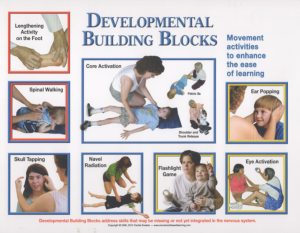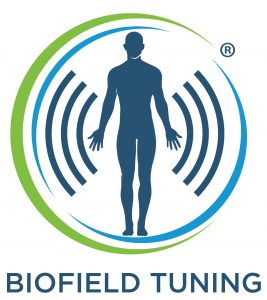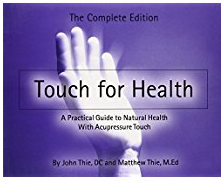Other Key Techniques that Kathy uses in her sessions
Claire Hocking’s Retained Infant Reflex Techniques
This is an extensive topic. First, I’ll share some information drawn from my own blog article on Understanding Retained Infant Reflexes:
What are Childhood Reflexes?
Many people who have cared for an infant are familiar with childhood reflexes, perhaps without knowing what they are: Put your finger in the infant’s hand and her fingers and thumb grip tightly around it (Palmar Reflex). The infant’s head turns, and the arm and leg on that side extend away from the body, and the other arm and leg bend (Asymmetrical Tonic Neck Reflex). Startled, the infant instantly throws his hands wide, head back, eyes open, breathing in – often followed by a cry – and then slowly closes arms and legs again (Moro Reflex).
Infants are biologically prompted to go through this series of reflexive movements. Some are for survival (Root-and-Suck Reflex – finding food), some are for upright posture and coordination (Asymmetrical Tonic Neck Reflex – learning to differentiate the two sides of the body, as well as the beginning of eye-hand coordination; Tonic Labyrinthine Reflex – develops the capacity for muscle tone).
Each reflex has a specific timeline for development. The infant is born with several reflexes operating; others emerge later. The whole process is sometimes referred to as the “infant reflex continuum.” Doctors often gauge the development of the child by the orderly progression of these reflexes.
Under optimal circumstances all reflexes emerge during the appropriate stage of the child’s growth, develop as a firmly functioning reflex, and then integrate into the overall neural system. At this point that stimulus will no longer trigger uncontrolled, reflexive action. It is vital that this occurs.
If various reflexes fail to emerge, develop, and integrate, the infant may become locked into a developmental holding pattern that prevents natural maturation of neural systems, leading to mild to severe learning and performance challenges.
Resolving these infant reflex challenges
Kathy says —
There are a number of techniques that have been developed to help “retained” infant reflexes to fully integrate, and I’m trained in several of them, including Masgutova Method, Rhythmic Movement Training (RMT), and Quantum Reflex Integration.
The system I call on more than any other (perhaps because its format is a direct fit with how I work with the Brain Gym session process) was developed and refined over the last 20 years by Claire Hocking, a Licensed Brain Gym® Instructor/Consultant in Australia.
I have seen remarkable changes in clients’ ability to think, focus, learn, and move in a coordinated way, once specific infant reflexes were resolved. I have described some of these experiences in blog postings and articles, which I’m listing here for you.
Understanding Retained Infant Reflexes
Fear Paralysis Reflex – 1
Fear Paralysis Reflex – 2
Moro Reflex
Symmetrical Tonic Neck Reflex
Asymmetrical Tonic Neck Reflex
Spinal Galant Reflex
If “reflexes” comes up as the priority modality in regard to the client’s “goal” issue, we identify exactly which retained reflex is at the core of the challenge, and complete the protocols that help to integrate it.
If you have specific questions about how reflex resolution work might apply to your own situation, or that of your child, please contact my office.
I have sponsored Claire Hocking here in the United States to teach her system. Please inquire if you would be interested in attending a similar class in the future.
Developmental Building Block Activities (BBAs)
Some people simply have a more sensitive, reactive nervous system; the stimulation of sights, sounds, tastes, fragrances, movements, textures, and more can be “too much to handle.”
The seven Developmental Building Block Activities support people of any age in developing a stronger internal sense of pattern and structure, so that this kind of “external input” can be more easily received and responded to. They’re a wonderful support for those diagnosed with developmental delay, sensory integration issues, ADD/ADHD, stroke, traumatic brain injury, autism, Down syndrome – or for anyone who may be overwhelmed by the sensory load from over-stimulating environments.
The BBAs are incredibly calming. They’re particularly helpful for very young children, or those who “resist” doing the Brain Gym activities themselves. For such individuals, the Brain Gym movements may be “too much information” for their nervous system to organize and store; they cannot identify or express their own overwhelm, so they simply refuse to participate, or fall into emotional over-reaction. After some time of experiencing the BBAs, many children are able to enjoy all kinds of things that were previously intolerable for them.
These techniques were developed by Cecilia Koester, as part of her Brain Gym® for Special Needs Providers course. Kathy Brown is fully trained by Cecilia, and is authorized by her to teach these techniques to others in a one-day workshop. (Please contact our office if this workshop interests you.)
If a specific client would benefit from any of the BBAs, Kathy will teach the parent or guardian how to facilitate them at home, so they can be done on a regular basis.
This link will take you to Kathy Brown’s blog article on this topic.
Biofield Tuning is the most recent addition to my toolkit for personal sessions, and I must say I’m completely amazed at its ability to resolve some issues that have resisted shifting using other modalities. It’s based on concepts that lie outside those of biological, neurological functioning, or even the energy systems of the body such as meridians; its effects can be explained through the physics terminology of frequency.
Origins of Biofield Tuning
This system was developed by Eileen Day McKusick over the last 25 years. Initially, she was looking for additional ways to relieve physical stresses in her clients and began using tuning forks on and quite near the body—with great success. She began recognizing that, when moving her activated (vibrating) tuning fork in the space around someone’s body, in certain spots the sound would change—becoming more sharp, warbly, or muted, for example—and that by repeatedly introducing the vibrating tuning fork into that spot, the true tone of the tuning fork would eventually return.
In addition to tonal change, each of those spots actually felt a bit resistant as the tuning fork initially encountered it—kind of sticky, or thick. (Of course, we’re talking about air here—so I’m describing a very subtle phenomenon!) The spot became less sticky/thick just as the true tone of the fork was evident again.
Then each spot could be “tracked” to the midline of the body. Eileen uses the computer-mouse language “click-drag-drop” for this process, which she describes as similar to how iron filings can be dragged by a magnet.
Following a session, clients often reported greater mobility in a particular part of their body, a release of long-held emotional distress, or an overall feeling of lightness as they move through life.
Eventually Eileen realized that all of the areas she encountered in regard to a person were contained within a field, about five feet out to the sides of the body itself, and two feet above the head and below the feet, with a boundary that was as readily identifiable as the “hang-up” spots she’d been encountering.
Always the researcher, she began poring through scientific/physics literature to see which other disciplines may have recognized and named this phenomenon. She came upon the concept of biofield, and began using that term for this field around the body, and the term incoherent frequency (meaning random, unorganized) in regard to the spots she was encountering.
Working hypotheses
Out of her experiences over two decades with this work, and this ongoing research, Eileen has developed several hypotheses to explain what she is encountering and exactly what is shifting when she employs the techniques she developed. She is now working with scientists in various fields to explore her hypotheses and explain her personal experience (and, now, the experience of hundreds of Biofield Tuning practitioners around the world) through scientific measurement.
One feature of Eileen’s hypotheses is that the biofield “contains the record of all our memories, embedded as energy and information in standing waves within this structure,” and that “Traumatic experiences on the physical, mental, and emotional levels give rise to pathological oscillations in the standing waves that act as a sort of noise in the signal and can cause a breakdown in the order, structure, and function of the physiology.”
How Biofield Tuning is accomplished
The process of Biofield Tuning is that of slowly drawing an activated tuning fork through a person’s biofield to detect these areas of incoherent frequency, one at a time, and repeatedly introducing coherent frequency (of the vibrating tuning fork) into them, until they clear. As Eileen describes it, “The tuning fork harmonizes the waveform of stress tangles and releases the trapped energy, which is neutral, so it can return to circulation.”
For more information on Biofield Tuning, I highly recommend Eileen’s book, Tuning the Human Biofield — Healing with Vibrational Energy. Her website is biofieldtuning.com and you can view a short introductory video here, of Eileen explaining her work. (YouTube offers many more videos on this topic.)
The bottom line:
No matter how this work is described or scientifically validated, I can attest to its effectiveness. Through more than two years of receiving my own Biofield Tuning sessions I am now operating in a much lighter, freer, more clear way, and I see similar results in my clients.
In every Brain Gym session I facilitate, I follow the client’s lead to whatever is the most appropriate way to move from “stuck” to “flowing” in regard to their goal. Biofield Tuning is now among the many protocols and techniques I have in my professional toolkit; when appropriate, that’s what’s called on.
In addition, clients may elect to see me for work focused entirely on Biofield Tuning, either in person or (believe it or not) as a distance session. This has opened up a new world for me with my clients, who are thrilled with this new skill I have on offer.
Touch for Health is a means of quickly easing the discomfort of common aches, pains and stresses of daily living. This system utilizes “muscle checking” (kinesiology) to determine imbalances in meridian flow, and restores balance with gentle acupressure techniques
For a more complete description, you can refer to this Blog article: “Introducing Touch for Health.”
Subscribe to Kathy Brown's email communications list
You can join one, two, or all three of Kathy’s email groups, for updates on:
• her Courses schedule • new Blog postings • her Book projects
like the upcoming Educate Your Brain for Reading
© Copyright Kathy Brown 2023. All rights reserved.
All photographs other than instructor portrait images ©Copyright Laird Brown Photography. All rights reserved.
Brain Gym® is a registered trademark of Brain Gym® International, Ventura CA
Please visit the Brain Gym® website at www.braingym.org.


